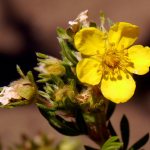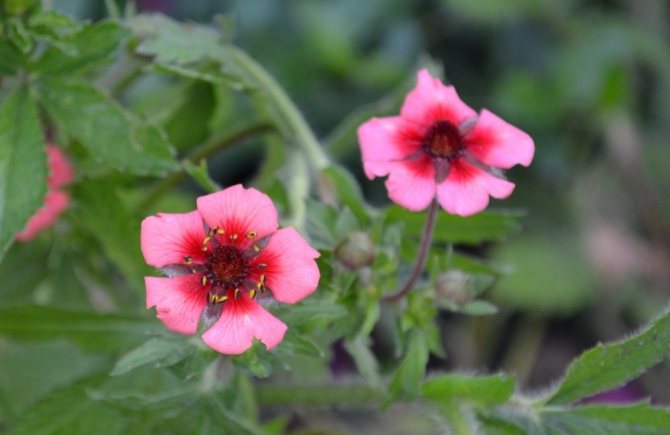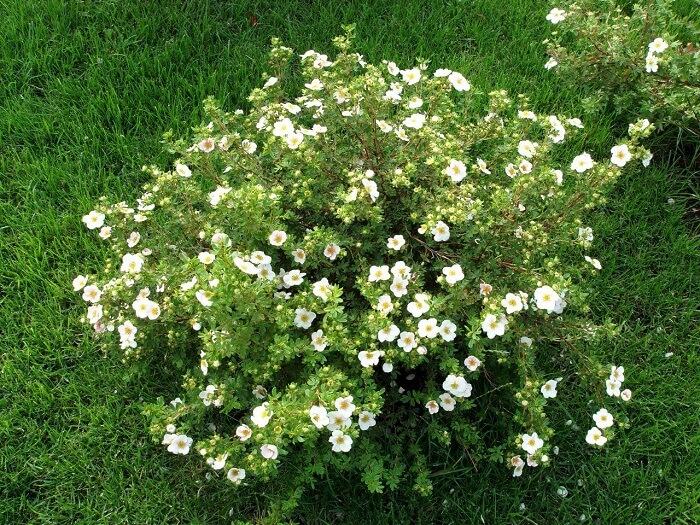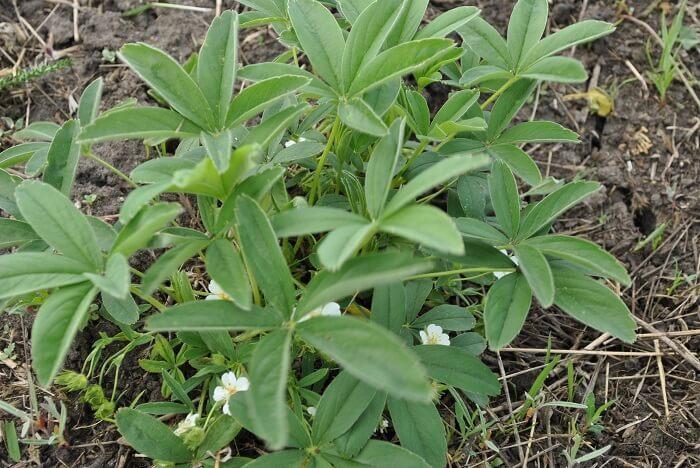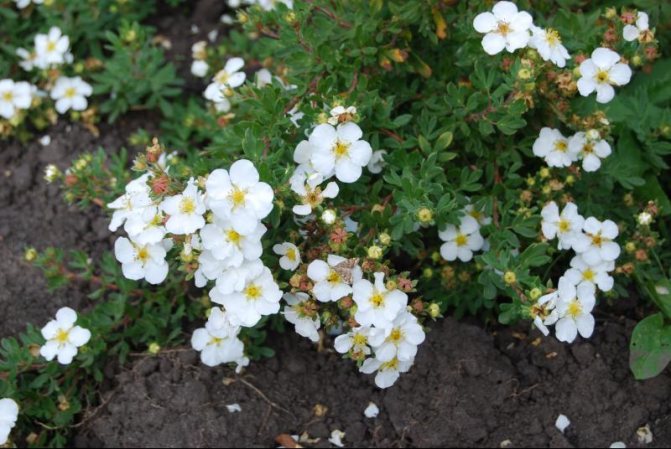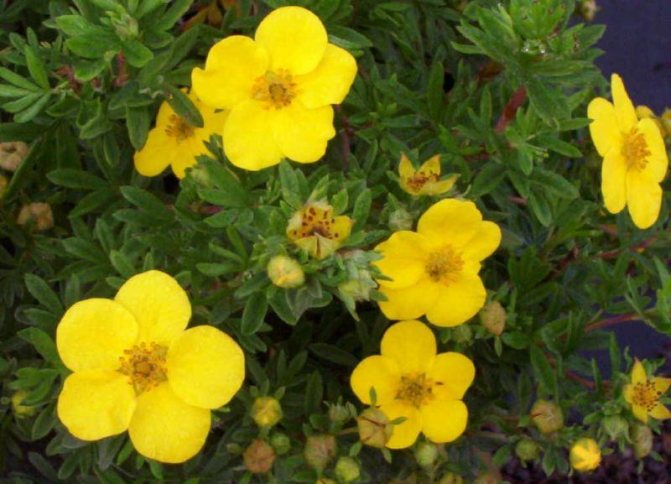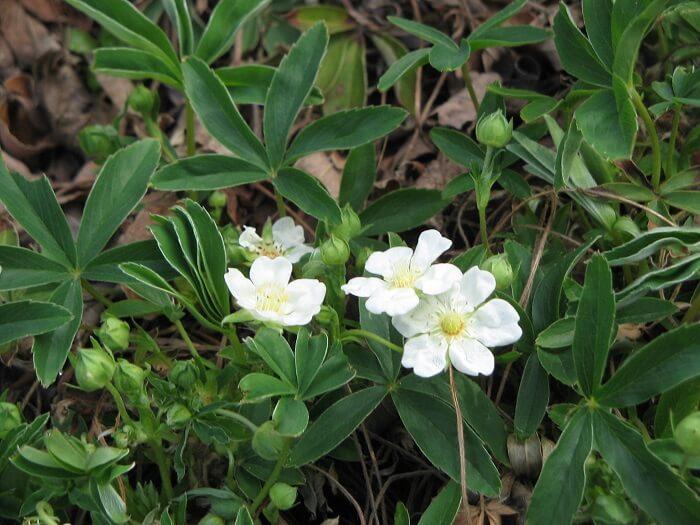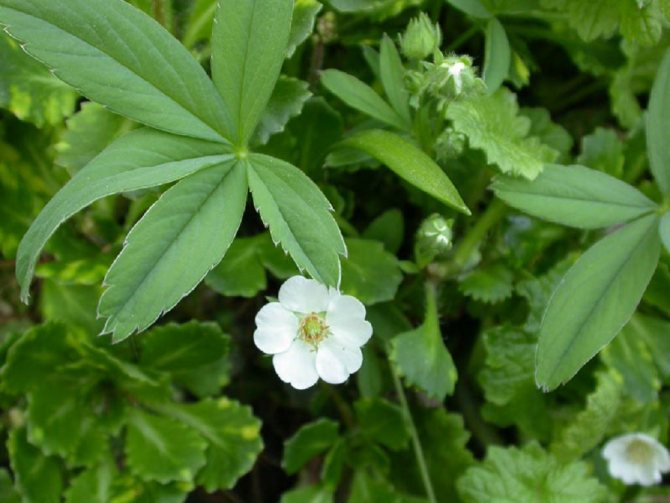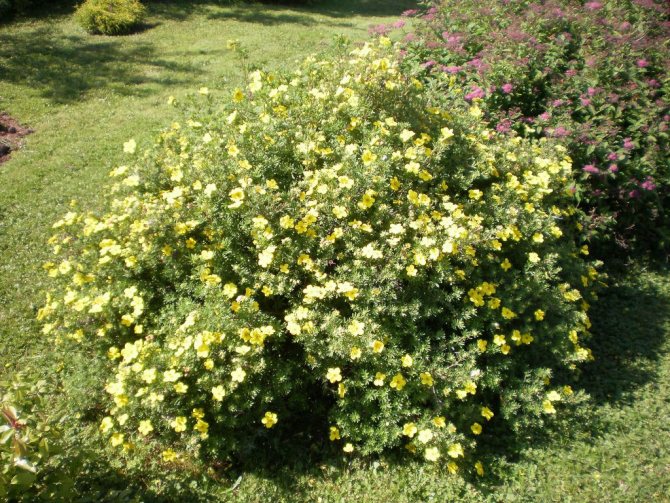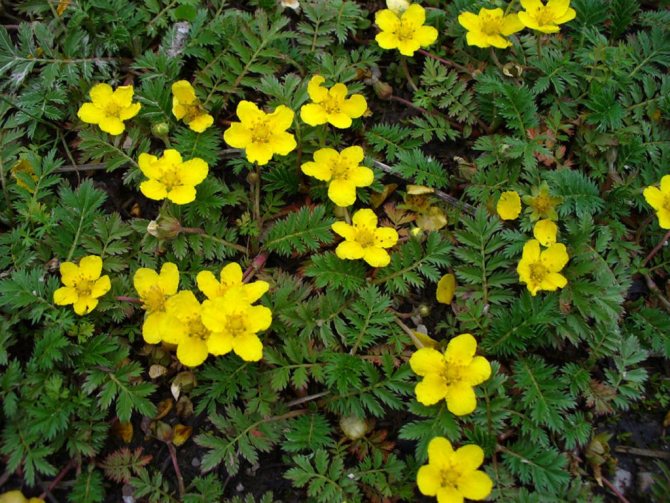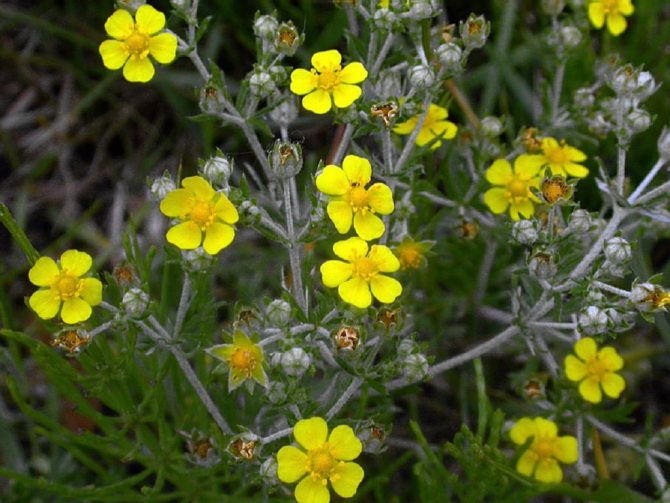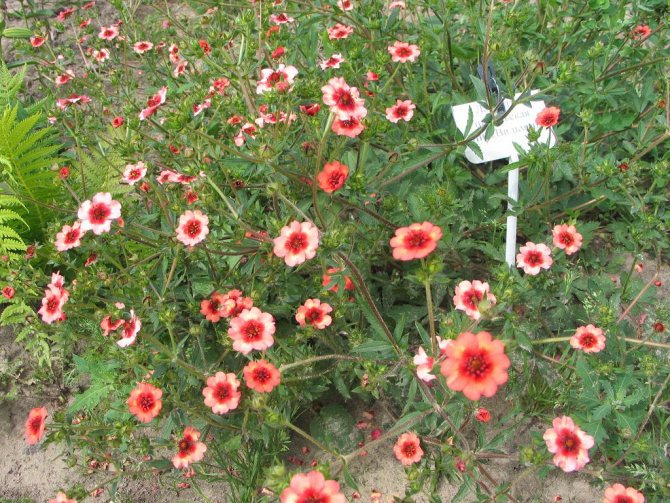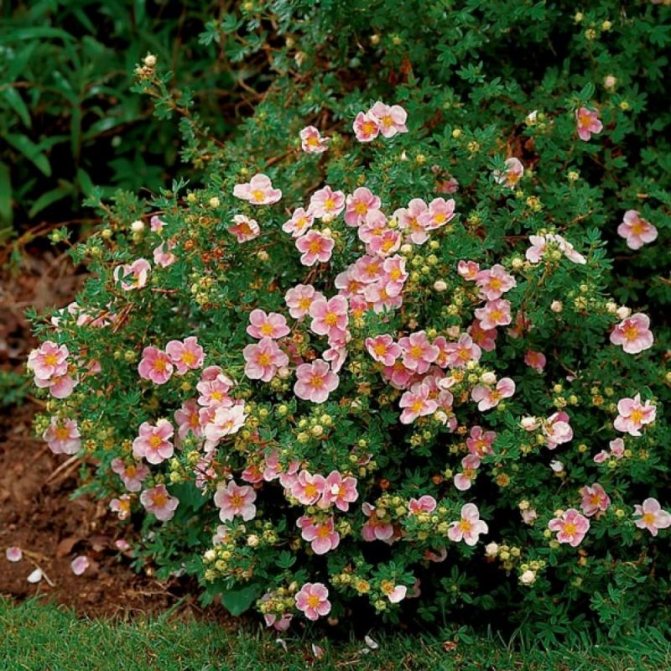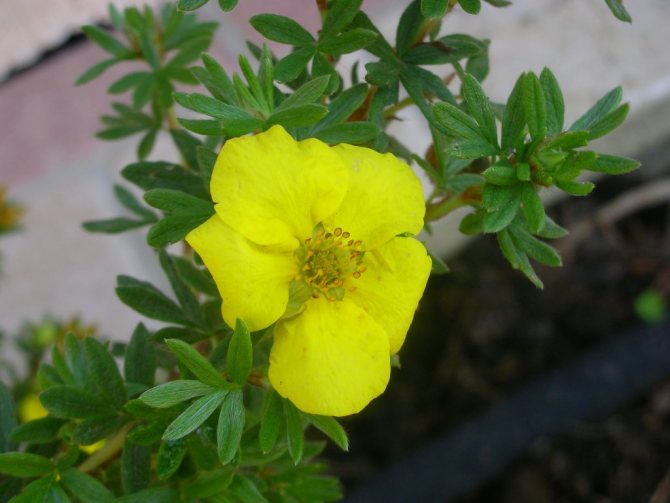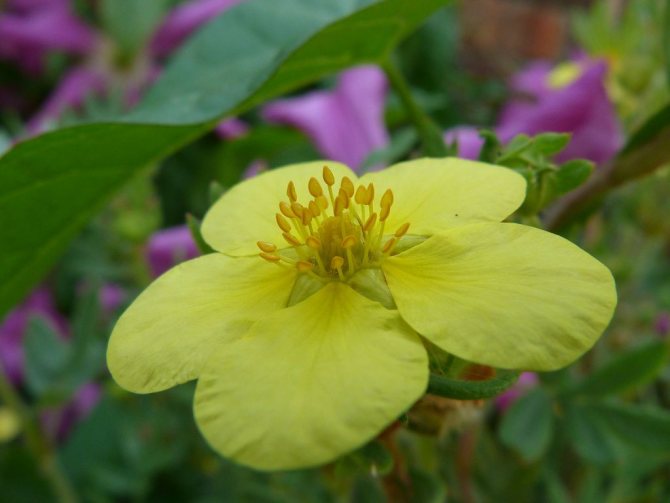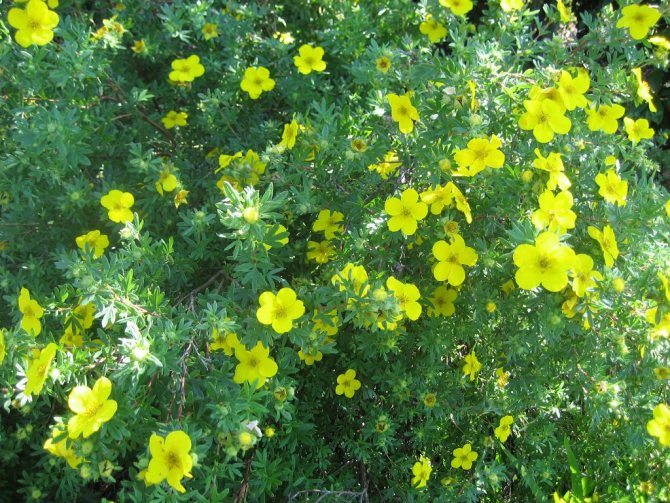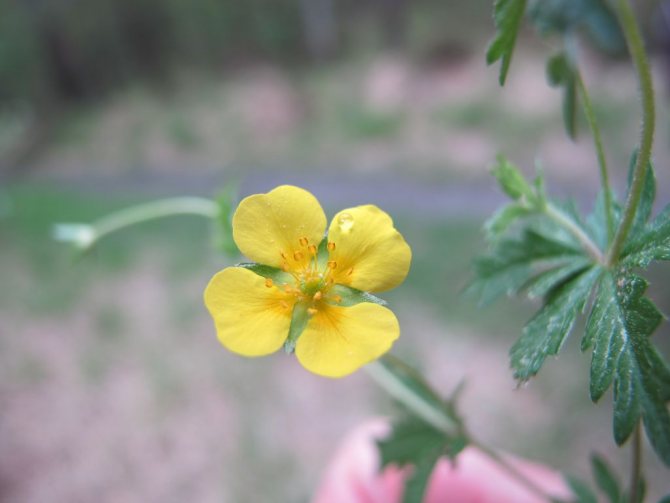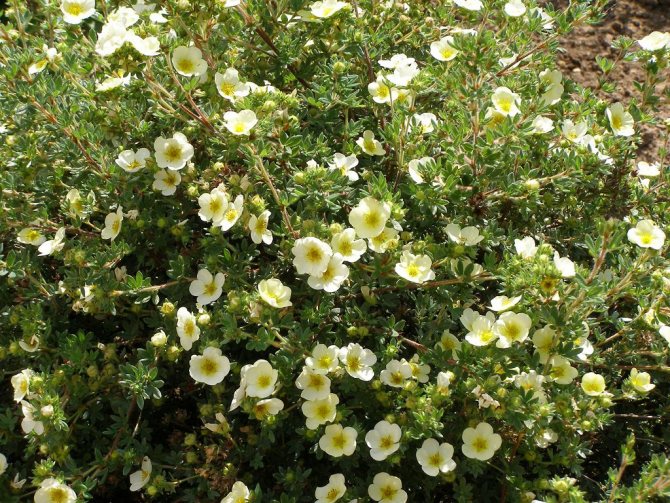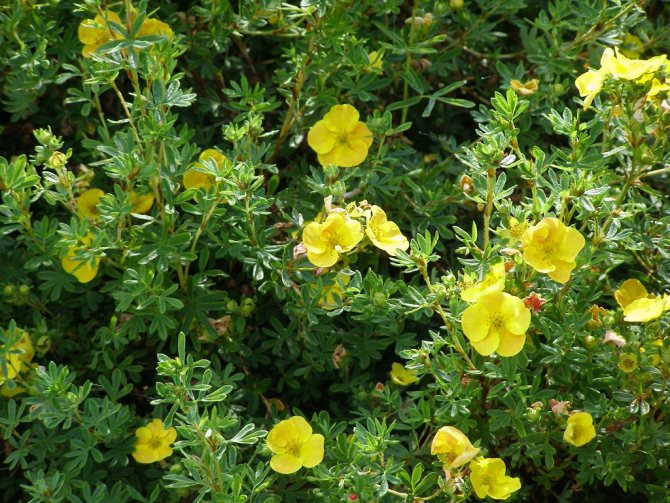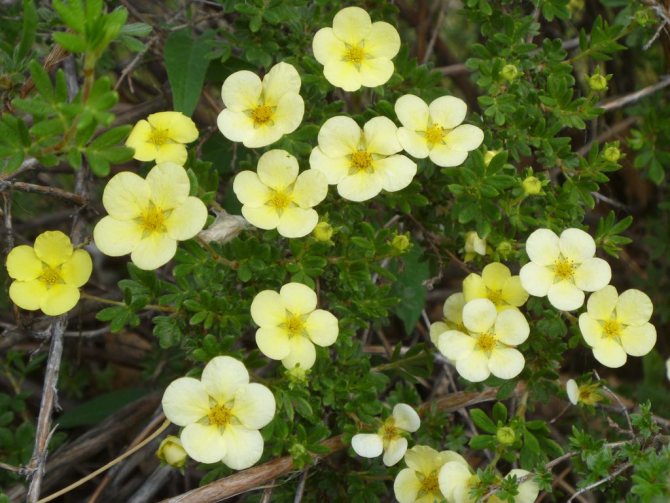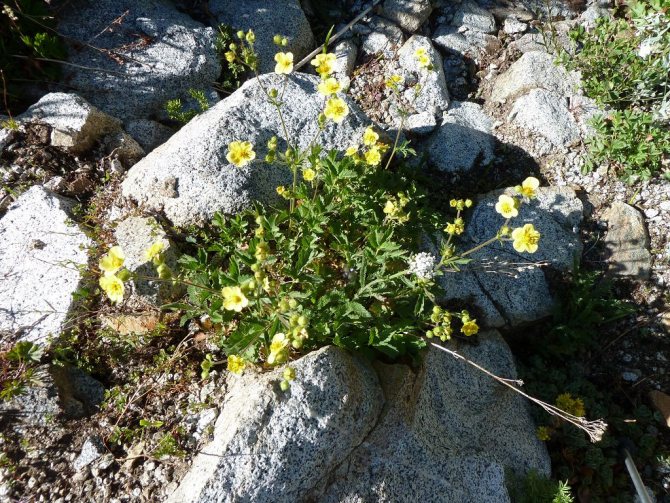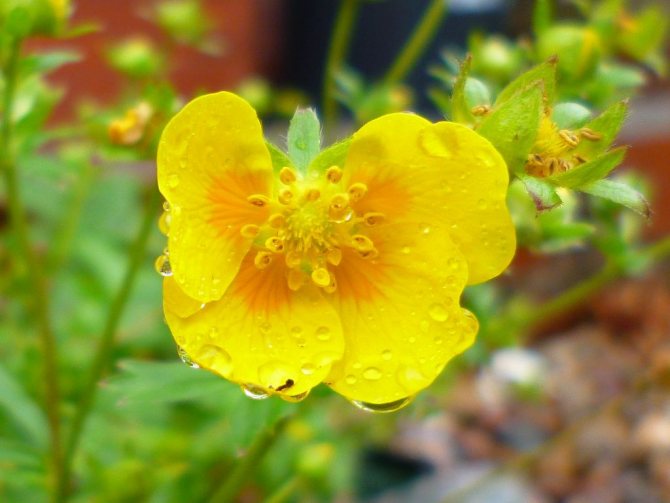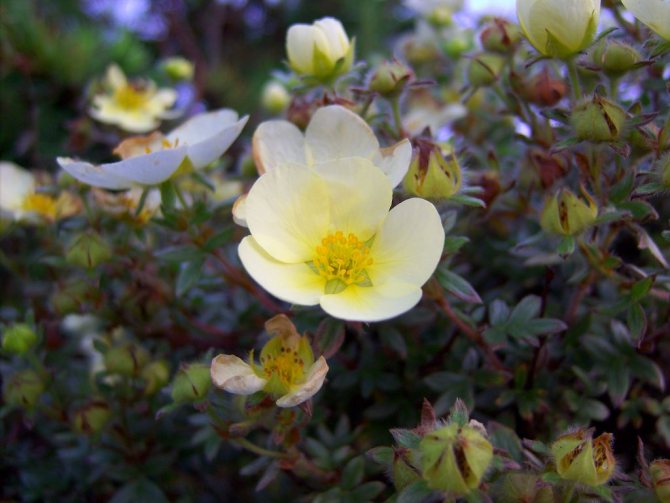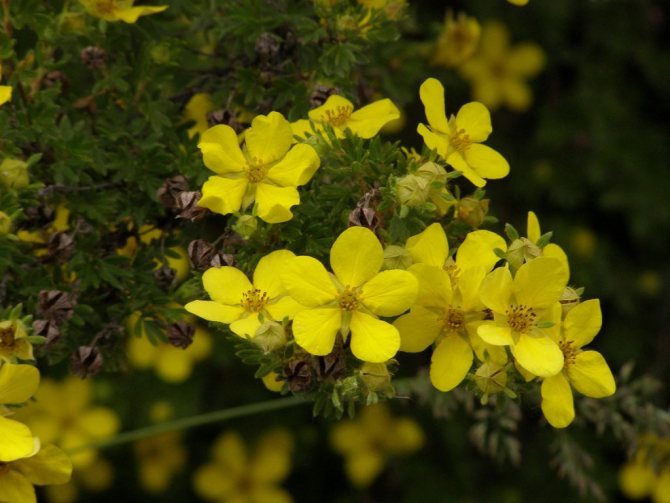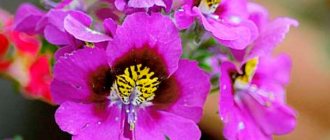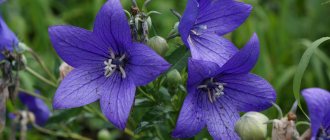Cinquefoil is a flowering plant from the Pink family. It became widespread throughout the northern hemisphere. Especially in temperate climates. You can meet Potentilla on forest edges and near fresh water bodies. Her genus is very numerous and varied. As a result of recent revisions of the classification, it has increased even more. Representatives are used as raw materials for medicines, for decoration of the site and in cooking. The scientific name - Potentilla - can be translated as "strong, powerful". This characterizes the ability to give vigor and energy.
Here you will find out:
Botanical description and photos of the plant
Cinquefoil is a deciduous shrub, reaching a height of fifty to one hundred centimeters. The plant can be called a long-liver: it lives for twenty - thirty years. Every year, ten to fifteen centimeters of new shoots appear.
The shrub is highly branched, the shoots are covered with a red-brown bark, which tends to flake off. The dense crown takes the shape of a ball. The leaf of a plant is formed from five parts (sometimes from three to seven). Hairy leaves, at first colored in a delicate shade of green, later acquire a silvery tint. They have a pointed tip, solid, sometimes curled edges. In length they reach three centimeters, in width - one. Ovate stipules grow together with petioles.
Climbing rose parade, gardeners reviews and a detailed description of this variety of roses.
Golden Medallion is a frost-resistant hybrid tea rose with abundant flowering.
Flowers bloom either singly or collected in racemose or corymbose inflorescences. They have five petals and are golden yellow in color. Each flower contains thirty stamens, due to this, the middle is overcast with a fluffy brush. After flowering, fruits appear, which are a composite achene. It seems that the bush is covered with brown "buttons" with fine hairs.
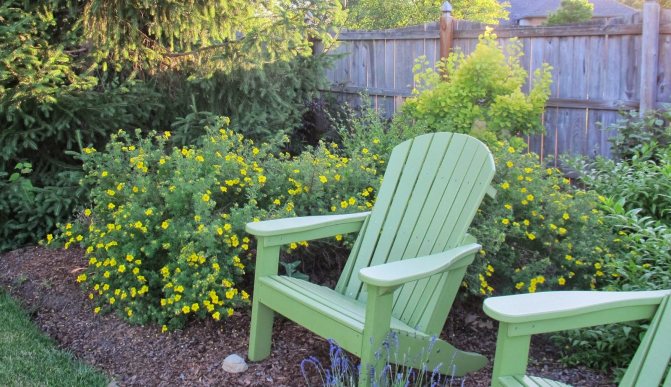
Photo. Shrub cinquefoil
The flowering period lasts from June to October, one bush is able to delight with sunny flowers for more than two months.
Short description
Cinquefoil is considered one of the largest genera in terms of the number of genera that are part of the Pink family. It consists of over 500 species that are ubiquitous throughout the northern hemisphere. Most of these species are represented in the form of herbal plants, although some shrub specimens are also found. The most common types of this culture are:
- White bloodroot;
- goose cinquefoil;
- erect cinquefoil (galangal-grass);
- red herbaceous cinquefoil.
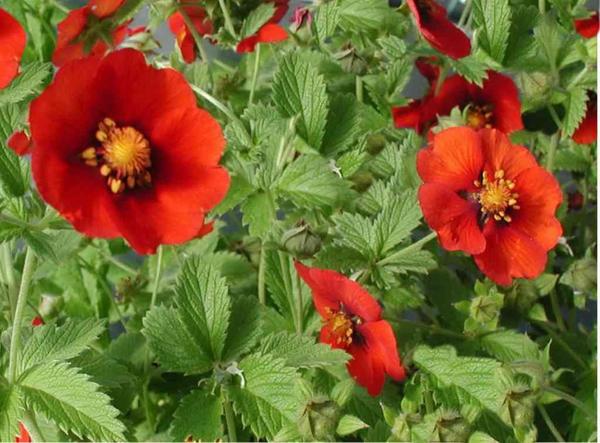

Herb cinquefoil herb
Planting and caring for a plant is largely due to its external structure. These are mainly perennial plants, in some cases - annuals or biennials. The stems are usually located straight, rise up or expand, less often - take root in the corners and creep. Their height reaches one and a half meters. The foliage is multi-sectioned or trifoliate, pinnate or finger-sectioned, colored green or gray-greenish.
In most types of Potentilla, the inflorescences are arranged in paniculate-corymbose or pseudo-umbilical inflorescences. Some varieties are characterized by single-flowered flowers.Flowering occurs from May to September. The color of the petals is predominantly yellow, but there are species with a different color:
- pink;
- white;
- red.
The fruit consists of achenes, the number of which varies from 10 to 80. They are most often bare, in rare cases covered with hairs, and fall off separately.
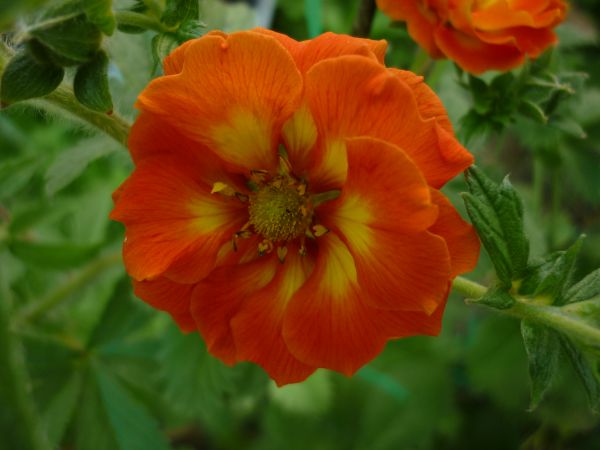

Potentilla flower
Planting in open ground Potentilla shrub
Shrub cinquefoil is planted in open ground in early spring, after the end of night frosts or in early autumn.
Seat selection
In order for the plant to actively develop and bloom profusely, it is important to choose a suitable site for planting. A well-lit place for growing Potentilla is chosen.
Important! It is recommended to choose the area in such a way that direct sunlight affects the plant in the morning or in the evening.
This condition should be carefully observed if varieties with bright, saturated colors: red, pink, orange, grow in the garden. With prolonged exposure to scorching rays, the petals of such varieties lose their saturation and fade. Placing in partial shade negatively affects Potentilla: it may refuse to bloom.
Choosing a soil for a plant
For planting Potentilla shrub, choose a soil with a small amount of limestone.
Loose, nutritious soil is preferable for planting Potentilla. It thrives on a slightly acidic ground with a small amount of limestone. Some species are more fond of sandy substances.
Sowing seeds
Gardeners with a lot of experience sow seeds directly into open ground. For beginners, the preliminary cultivation of seedlings is recommended.
For sowing seeds, prepare a wide container with drainage holes. It is filled with a nutrient substrate, consisting equally of peat and humus. The soil is moistened, sown is carried out, after which the seeds are covered with a small layer of earth. The box is covered with transparent glass or polyethylene. The container is placed in a room with a temperature of sixteen to eighteen degrees Celsius.
Care for the seedlings is simple: periodic watering and airing the greenhouse. Seedlings are not expected soon. They grow slowly at first. When three leaves appear, the strongest seedlings are transplanted into separate containers. In summer, seedlings with well-developed roots are sent to their permanent residence in the open ground.
Planting cinquefoil saplings
Dig a hole three days before planting. Its size should be twice the volume of the roots. It is advised to use lime gravel as drainage, because calcium is necessary for the healthy development of the plant.
The pit is filled with a nutrient mixture consisting of one part of humus, one part of leafy soil, half of a part of sand with grains of medium diameter and complex mineral dressing in the amount of one hundred twenty to one hundred and forty grams.
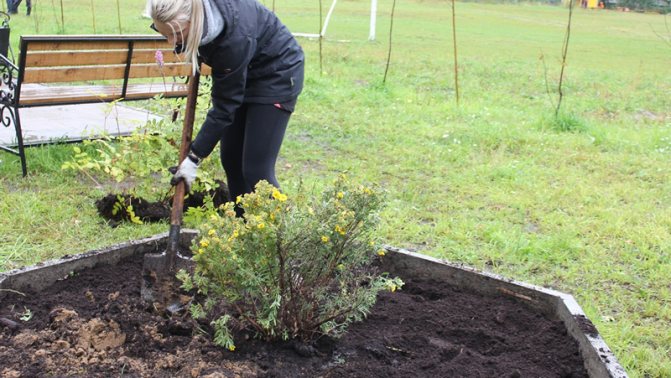

Before placing the seedling in the hole, fill it with a nutrient mixture.
The seedling is placed in a hole, straightening the roots. The resulting voids are filled with earth, periodically compacting the layer to avoid leaving air spaces. The root collar should protrude slightly above the ground. A distance of thirty centimeters is observed between the seedlings. At the final stage, young plants are watered, and the rounded area next to them is mulched using straw, grass or chips.
Planting in autumn
Cinquefoil can be planted outdoors in the fall using seeds as seed. In winter they undergo stratification, and in spring they show green leaves above the ground. In this case, they are seated in the spring.
Diseases and pests
Periwinkle grass: description, planting and care in the open field
The culture in question is relatively resistant to most harmful insects and diseases, making it much easier to care for it.Occasionally, plantings are affected by rust, spotting or powdery mildew. In this case, Bordeaux or colloidal liquid is used on perennials, while annual plantings are usually not treated at all. The main pest of Potentilla is scoops, against which appropriate insecticides are used, for example:
- Fufanon;
- Decis Profi;
- Fitoverm.


Potentilla diseases
Autumn care, shelter for the winter
After the annual plants lose their attractiveness in the fall, they are removed from the plot. The soil on the site is dug up, applying fertilizers. When the shrub cinquefoil stops flowering, all its shoots are cut by a third and the plantings are sprayed with Bordeaux liquid to prevent diseases.
Perennial grass Potentilla is rarely covered for the winter, since they are quite winter-hardy. Rooted cuttings and young seedlings are subjected to the usual procedure, using spruce branches for this purpose. With the onset of spring, this shelter is dismantled as quickly as possible.
Cultivation of Potentilla in cultural conditions is not particularly difficult with certain knowledge. Correctly built cultivation techniques will allow you to get beautiful and luxuriantly flowering plantations.
Caring for cinquefoil shrub
Shrub cinquefoil is not very demanding for care.
Growing Potentilla shrub does not require much effort and time. Every florist can carry out elementary care.
Cinquefoil is able to withstand some drought, but the gardener must still carefully monitor the moisture content of the earth. The plant is usually watered once every two weeks, pouring ten to twelve liters of water under each bush, previously heated in a garden container to ambient temperature.
In the case of mulching the soil, weeding is rarely done, removing only large weeds. Every week, the soil is loosened, providing fresh air to the plant. During this procedure, great care is taken not to injure the roots. Potentilla is fed three to four times during the whole season, using complex fertilizers for flowering plants, a solution of mullein with ash or an extract of vermicompost.
Shrub pruning
The plant is pruned in early spring and fall. If the gardener breeds compact Potentilla, they carry out a sanitary procedure, get rid of broken and dried branches. Strongly branched shrubs are shaped like a ball, pyramid, or pillow. Flowers that have crossed the seven-year threshold should be rejuvenated by cutting out one third of the old branches annually until they are completely renewed.
Pruning is easily tolerated by the plant. If a gardener grows cinquefoil as a hedge, it is formed in a special way.
Interesting! To give the plant the shape of a ball, cut off excess shoots using a hoop or ball.
Erect cinquefoil (P. erecta)
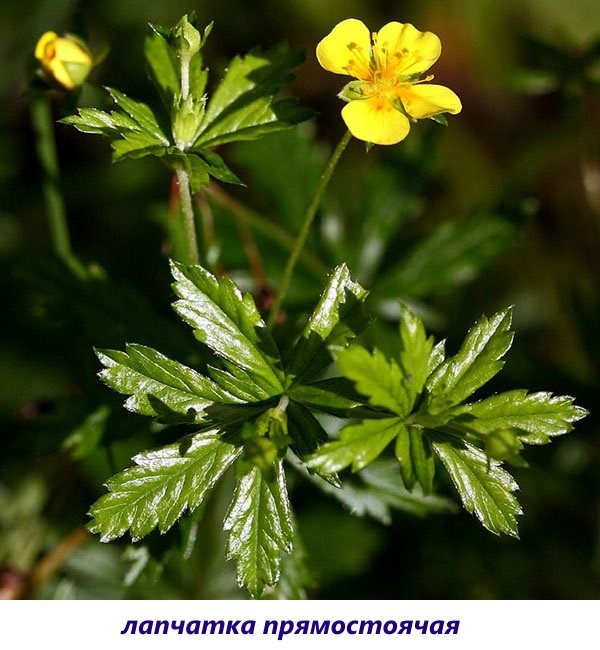

From the western borders of Russia to Altai, from the tundra in the north and to the Caucasus in the south, another common species can be found. This plant, like the cinquefoil goose, is a herbaceous perennial, however, it differs in the size of the aboveground part, the appearance of flowers and leaves.
Erect cinquefoil is easy to recognize by its thin, branching stems, on which trifoliate or five-toed leaves with serrated edges sit. Plants bloom from May. But unlike its congeners, the corolla with a diameter of 15 to 25 mm consists not of five, but of four golden petals. Flowering lasts until September. At the same time, fruits ripen, which are carried around by wind, rain and with the help of animals.
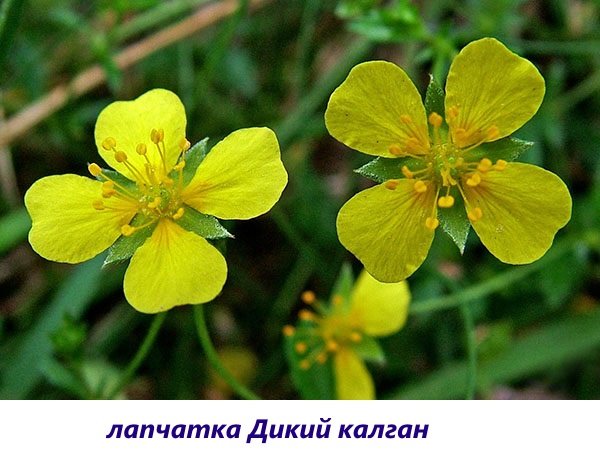

In addition, the culture is an excellent melliferous plant and a source of natural spicy raw materials, thanks to which the popular name used for erect cinquefoil appeared - galangal herb or wild galangal.
Plants with a height of 15 to 50 cm are very unpretentious.They endure trampling staunchly, feel great in direct sunlight and, thanks to a thickened lignified rhizome, winter without loss.
Breeding methods for Potentilla shrub
Cinquefoil reproduces by seeds, cuttings, dividing the bush and cuttings. Propagated by layering and cuttings in July - August, bushes are divided in spring or autumn. To separate the rhizome, a bush, not younger than four years old, is taken out of the soil, the roots are thoroughly washed and divided into parts with a sharp clean knife, each having two to three buds. A stimulant is used for the formation of roots and the cuttings are planted in the ground without deepening the buds. Distance - twenty - forty centimeters.
Cuttings are obtained from the ends of the shoots. Rooted in moist perlite for one and a half months. Planting in a shady area of the garden is acceptable. In this case, they are placed under a jar or plastic bottle. The buds that appear are cut off, preserving the strength of the flower. In winter, the cuttings are covered.
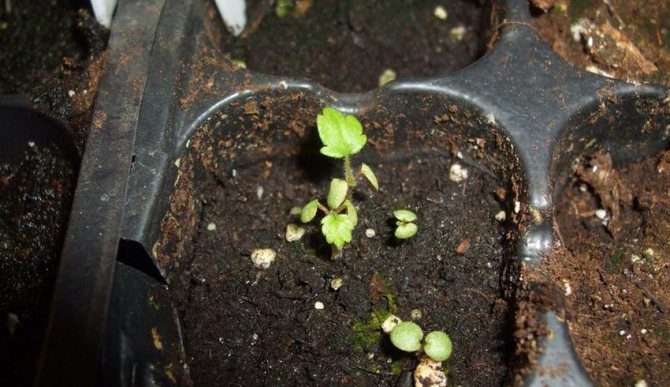

Shrub cinquefoil reproduces by seeds, cuttings, dividing the bush and layering.
The easiest way is to propagate cinquefoil by layering. In the spring, a shoot is chosen, incised, laid down with the incised side, in this place it is attached to the ground and sprinkled with earth. When the cutter has its own roots, it is separated from the mother plant and planted in a new place as an independent bush.
Various types of Potentilla grow in their summer cottage
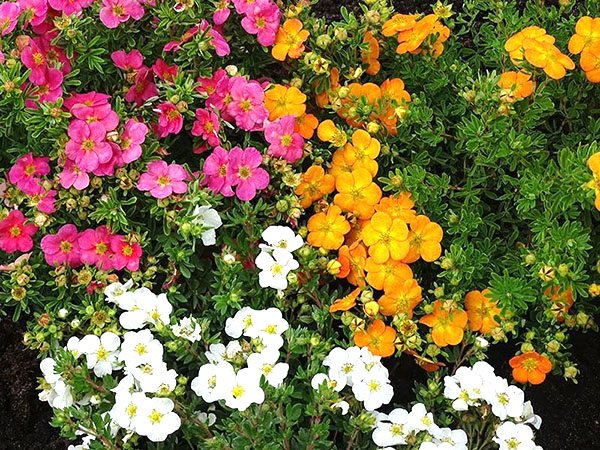

Plants collected in the genus Potentilla play an important role in the variety of species of the temperate climatic zone. This is not surprising, because according to recent studies, more than 320 independent species can bear this name, among which there are one- and two-year-old crops, perennials, undersized, creeping or creeping specimens, as well as shrubs.
Differing in size and shape, the plants still have a lot in common. For example, most of them are inhabitants of the Northern Hemisphere. Cinquefoil can be found in Norway and the northern Caucasus, their range stretches from Western Europe to the Far East. Only on the territory of Russia there are about a hundred varieties.
Another common feature is the split foliage, thanks to which the plant got its name, and a similar structure of flowers, reminiscent of a distant relationship with rose hips, strawberries, gravilat and plum, as well as members of the Pink family.
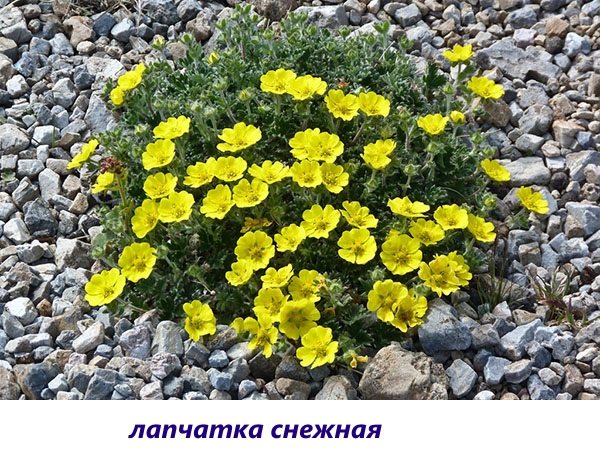

Despite the inconspicuousness of many representatives of this genus, a person has long noticed and appreciated the plant.
Wild species have been used in folk medicine since ancient times. Rhizomes and cinquefoil, rich in bactericidal, astringent, hemostatic substances, are used in modern medicine, as well as in the production of alcoholic beverages, canned food and in the manufacture of natural dyes.
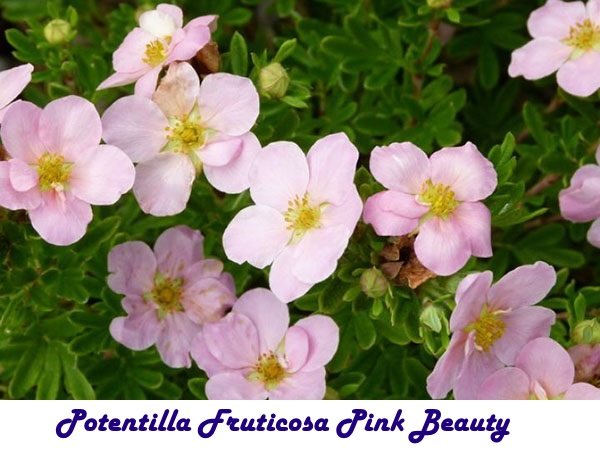

Today, perennial species, for example, shrub cinquefoil, varieties and hybrids obtained as a result of selection are popular with owners of household plots.
Potentilla plants with decorative foliage and flowers of yellow, white, pink and red shades are valued for their unpretentiousness, versatility and variety.
The use of a plant in landscape design
With the help of Shrub Potentilla, they decorate any garden compositions. Designers often use this plant in their projects, paying tribute to unpretentiousness and versatility. The shrub is planted in a stone garden among boulders as a tapeworm.
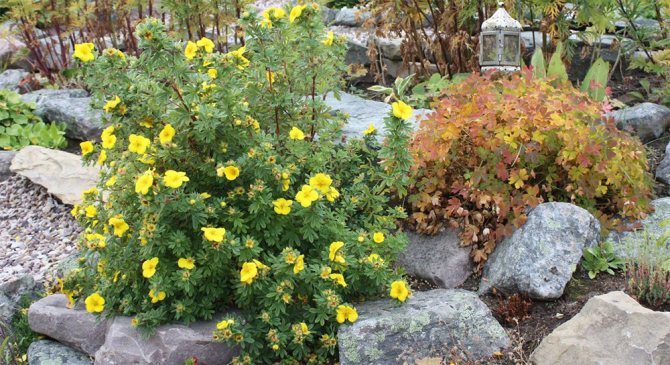

Shrub cinquefoil is in good harmony with any plantings.
Group plantings are also a great place to plant Kuril tea. If a designer creates a garden project in an oriental style, he must pay attention to the bright cinquefoil, which effectively complements the overall picture.The classic color of flowers is a bright yellow shade, but varieties with white and pink flowers look great in the garden. You can decorate the garden with the varieties "Lovely Pink", "Red Ice" and many others.
Interesting! Shrubs above one and a half meters are used for landscaping hedges and borders. With the help of a haircut, they are given the necessary shape. A low hedge serves as the border of the functional areas of the garden, fits perfectly into the composition as a ring or edging.
Cinquefoil is in harmony with any decorative plantings. Bright flowers, shrubs, trees look great in a group with Potentilla. You can combine Kuril tea and barberry or Bumald's spirea.
A special place is given to the combination of Potentilla with conifers. If you look at it from the point of view of the color scheme, then flowers of blue, blue and white colors look great with the plant.
Main varieties
There are about 30 and all are considered decorative. Let's take a closer look at the most popular ones.
"Princess" syn. "Blink"
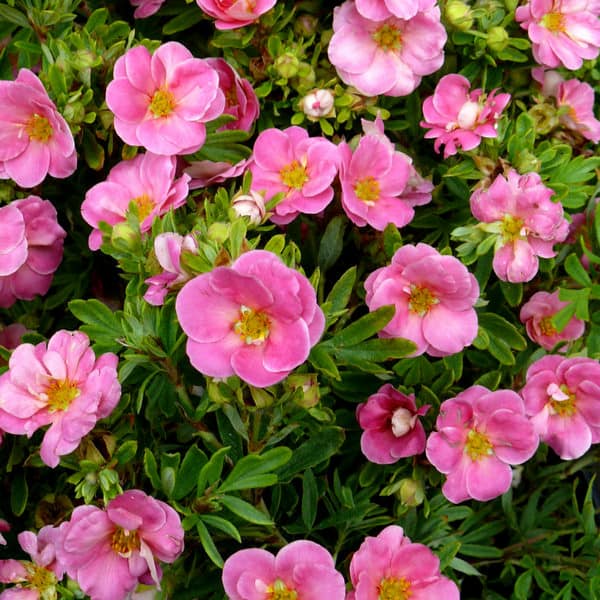

- The shrub is low, about 60 cm, but over time it grows up to a meter in height.
- From the second half of May until the end of the summer season, gently pink flowers bloom on the bush with a diameter of about 3 cm.
- By the end of the flowering period, they fade to an almost white hue.
"Annette"
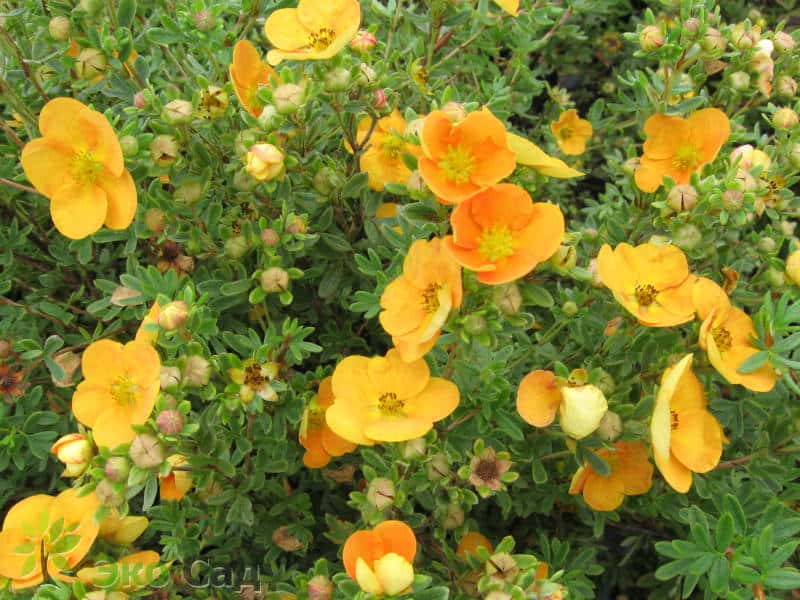

- The plant is undersized, only up to 1.5 in height, reaching a maximum with good care of 80 cm.
- The flowers are large, the color is from bright orange to rich yellow.
"Pink Queen"


- Plant height is about 60 cm. The crown is dense and branched. The branches have a creeping structure.
- The leaf plates are leathery and green, of a light shade.
- The flowers are large, light pink, flowering from the second half of spring to mid-October. If the shrub is planted in a sunny place, then the flowers fade by the end of summer to an almost white color.
Beneficial features
Shrub cinquefoil is used as a folk remedy.
Along with the decorative properties, shrub cinquefoil has useful qualities. Fresh leaves contain a lot of ascorbic acid, vitamin A. In shoots and leaves, tannins, catechins, essential oils and phenol carboxylic acids are found. In alternative medicine, for mental and nervous diseases, an infusion of the leaves and flowers of the plant is used. Some people drink the infusion of the branches to treat abdominal pain.
Children's doctors consider the infusion of Kuril tea to be an excellent remedy for use in case of dysbiosis. The infusion is diuretic, normalizes metabolism and helps with urinary incontinence at night.
Composition and medicinal properties
Erect, goose and white cinquefoil is used as a medicine in folk and traditional medicine. All parts of the plant are suitable for preparing potions. Usually, a decoction, alcoholic infusion or tea is prepared.
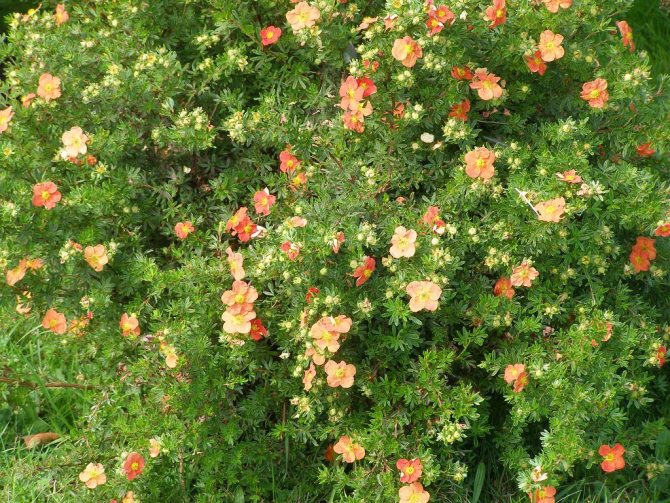

The drugs have a beneficial effect on the gastrointestinal tract, facilitate the treatment of pancreatitis, stomach ulcers, urolithiasis, as well as colitis and diarrhea of infectious origin. Potentilla decoction helps with colds and coughs, as it is an effective mucolytic. Also, the plant has a beneficial effect on the kidneys and has a diuretic effect. White cinquefoil is especially rich in active elements, acids, saponins, flavonoids. Alcohol tincture, even in official medicine, is recognized as an effective remedy for thyroid diseases.
Outwardly, cinquefoil is used to relieve burns, heal weeping wounds and stop bleeding. With its help, they get rid of fungus, stomatitis and periodontitis. The drugs are effective in lowering blood pressure. If for hypertensive patients this will be a big plus, then Potentilla is categorically contraindicated for people with low blood pressure.
Decorative use of Potentilla shrub
This bush is gaining more and more popularity among gardeners and landscape designers in Russia due to its ability to bloom all summer and autumn until the very frost.
There are usually many flowers and they are very bright, while the color scheme is replete with variety, although its original color was exclusively yellow. And if you add to this its unpretentiousness, you get the perfect shrub for hedges. Its only drawback is that it grows for a rather long time, it will take about 4 years to wait for a meter-long plant, already in the second year of life it will bloom, and by the third it will be dotted with flowers.
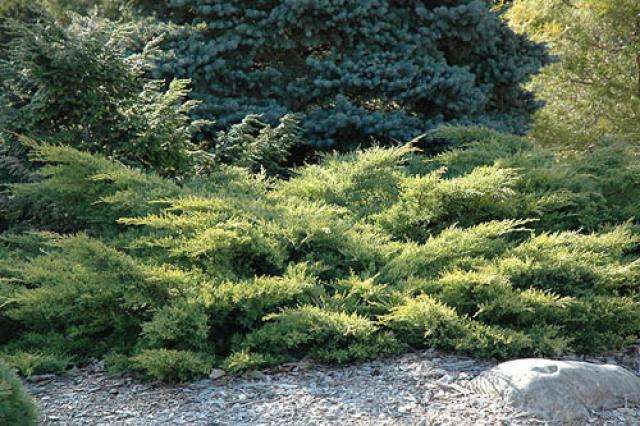

Growing Kuril tea
Kuril tea, as mentioned above, the plant is unpretentious and can grow everywhere from the Arctic Circle to southern latitudes. Photophilous, grows faster on fertile soil without excess water, neutral to soil acidity, usually does not require watering.
When planting in groups and creating a hedge, the bushes are planted at a distance of 70-80cm, for maximum bushiness, the distance between plants should exceed 1m. The depth of the hole for planting is up to 70 cm into which drainage (broken red brick, expanded clay) is poured into 20 cm, then another 20 cm of a mixture of sand with humus, and only then the plant is planted and sprinkled with garden soil.
Since the flowering tops of the plant die off in winter, it is better to trim the plant from old shoots by about 10-20 cm in spring - this will cause accelerated growth of new shoots and give a better look to the shrub.
Attention!
The plant has a small feature that often leads to gardeners' mistakes, the shrub often does not release leaves until mid-May, when everything around is hedgehog green. Therefore, if you see a bare bush in the spring that does not show signs of life, do not rush to throw it out by the end of May, it will bloom, and in a couple of weeks the first flowers will bloom.
As practice shows yellow shrub Potentilla Kuril blooms better and is more durable than other artificially bred flowers.
Cinquefoil after flowering


Autumn care
In autumn, the annual cinquefoil should be removed from the site after its appearance becomes unattractive, while it is necessary to dig the site with fertilizer. In shrub Potentilla, when it finishes blooming, all shoots should be shortened by 1/3, and for the prevention of diseases, the bushes should be treated with Bordeaux liquid.
Wintering
A perennial cinquefoil does not need shelter for the winter, because it has a high frost resistance, and it does not matter whether it is a herbaceous plant or a shrub. Young seedlings planted in autumn and rooted cuttings need shelter.
Fertilizing and feeding
In addition to the mineral fertilizer applied during planting, Potentilla needs the following dressings:
Potassium sulfate and phosphate fertilizer:
- 25-30 g of both per bucket of water;
- 1 bucket is enough for 1 bush;
- application time - spring.
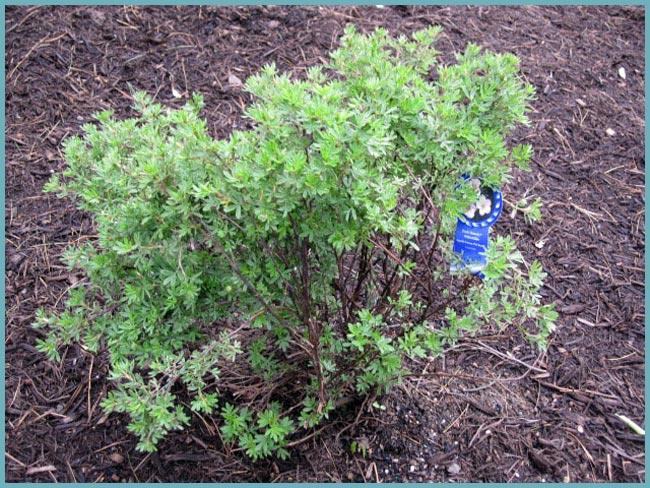

For abundant flowering, the culture needs regular feeding.
Phosphorus and potash fertilizing:
- use any, in accordance with the instructions;
- application time - before flowering.
How to apply
Medicinal compositions from Potentilla leaves can be supplemented with dried root, which also has medicinal properties.
Tea for prostatitis
With the pathology of the prostate gland, treatment can be carried out with the help of goose gooseberry. The action of trace elements contained in the medicinal plant will help relieve inflammation and reduce the symptoms of the disease.
Reception of goose cinquefoil from prostatitis optimizes the work of the gland, removes harmful substances from the body and strengthens the general condition of internal organs.
Ingredients:
- Dried leaves of Potentilla goose - 2 tsp
- Water - 250 ml.
How to cook: Pour the amount of herbs required according to the recipe with hot boiled water. Insist the mixture for 10-15 minutes, strain.
How to use: Drink tea in small sips. Don't add sugar.
Result: Reducing pain and discomfort, improving general condition.
In order to give the tea a taste and increase its benefits, you can add a decoction of peppermint and lemon balm, taken in equal amounts.
Broth for prostatitis
You can prepare for prostatitis a milk broth of goose cinquefoil.
Ingredients:
- Dried leaves of Potentilla goose - 10 g.
- Milk - 200 ml.
How to cook: Cover the medicinal herb with cold milk. Bring the mixture to a boil and cook for 5 minutes. Strain and let cool.
How to use: Take half a glass of ready-made broth twice a day.
Result: Anti-inflammatory and restorative effect on the prostate gland.
Tincture for prostatitis
It is possible to receive a more concentrated aqueous tincture.
Ingredients:
- Dried Potentilla Goose Root - 3 tbsp
- Water - 1 liter.
How to cook: Bring water to a boil and add chopped root. Insist for an hour, then strain.
How to use: Drink 1 glass of medicine half an hour before eating three times a day.
Result: Reduction of pain, restoration of the normal functioning of the prostate gland.
Appearance and growing area of Kuril tea
Pictured is a flower of Kuril tea
Outwardly, Kuril tea is a rather beautiful and attractive plant. It has bright flowers, usually with five petals (yellow, white, orange, pink or even red). It is a mistake to believe that this plant grows only on the Kuril Islands. The shrub is unpretentious, capable of growing even in permafrost conditions, and its range covers most of Russia. It grows in meadows with mixed vegetation. In recent years, the plant has been cultivated throughout central Russia as an ornamental one; now its yellow flowers can be found in many cities of Russia.
How goose cinquefoil reproduces
Under natural conditions, cinquefoil goose reproduces in a vegetative way, that is, by rooting a mustache. The creeping stem easily forms an independent plant that takes root without difficulty. You can get a young bush by planting a root tuber.
Seed reproduction is of great importance for the spread of Potentilla goose to new territories. Seeds with the flow of water and animals are transported over long distances, where they germinate quickly and are capable of vegetative reproduction already at the age of two.
Medicinal use of Kuril tea
The chemical composition of this tea
Due to the fact that this tea grows in places with a cold climate, it allows it to absorb a variety of nutrients and vitamins. For example, it contains components such as vitamin C, flavonoids, which are antioxidants and reduce the risk of radiation sickness. It also contains rutin, tannins and various tannins. It also contains components that help to quickly and easily assimilate all the vitamins found in this tea, so the tonic effect of this tea begins to be felt immediately after the first mug with the drink.
Rules for the preparation of Kuril tea
Collecting a plant
The procurement of Kuril tea begins during its flowering period and can continue until autumn, when the flowers fall off and lose their properties. In order to prepare the maximum amount of tea, tough gloves can be used, since the branches of the plant are quite strong and can injure.
Drying the plant
The plant must be sorted out and the yellowish leaves must be separated. You can dry them either in the shade in the fresh air, or in a warm room that is well ventilated. It is recommended to cover them with gauze so that various debris or insects do not get on the drying, Kuril tea is dried quite simply and does not rot.
Feedback on the results of the application
My first acquaintance with Potentilla was back in 1993, when, as a child, I was poisoned. I lay for two days with severe poisoning, I could not swallow any medicine, I immediately vomited. Then my mother remembered the root and brewed it. I drank and, literally, after a couple of hours I felt better. Recently, I started having problems with inflammation in the intestines and in the stomach. And then, I remembered about him and ran to the pharmacy. I brewed cinquefoil and drank like tea. The pains went away, the stool returned to normal! My joy knew no bounds!
Marinittta
A couple of years ago there was a period when the eldest son was worried about angina every month. The treatments prescribed by the pediatrician were of little help. So I started looking for help on sites that give herbal prescriptions. And there one woman writes that it was Lapchatka who saved her from angina forever. And I decided to try this magical herb too! We gargled with infusion for only 4–5 days and the sore throat was gone! Since then we have forgotten about it!
UDACHAVRUKAH
I started drinking Potentilla tea. It also has a huge plus - a set of substances for maintaining the gastrointestinal tract and kidneys, so it is also an excellent source of flavonoids - which protect against many things, including even cancer. I drink tea 1-2 times a day with a spoonful of sugar - with it the flavoring bouquet is just wonderful. Now my colleague is also drinking it, who recently noted that he has become sick much less often.
Coffeeman
Contraindications for use
Since cinquefoil is a herb with high biological activity, its use should be approached responsibly.
First of all, due to the property of the plant to lower blood pressure indicators, hypotensive patients should use it with caution. Also, the use of Potentilla is not recommended with increased blood clotting.
Those who have been diagnosed with kidney stones should use Potentilla products very carefully, since large stones can get stuck in the ureter when they exit.
In addition, goose grass can irritate the gastric mucosa, so you should refuse to use it in any form in case of exacerbation of gastritis.
Many are interested in the answer to the question of whether it is possible to take preparations based on Potentilla during pregnancy. Formally, there is no ban on the use of decoctions and infusions of this herb. However, you should first consult your doctor, as goose grass is a plant with high biological activity.
But for nursing mothers, it is better to refuse Potentilla preparations so as not to provoke an allergic reaction in a newborn.
Goose cinquefoil is considered a unique plant that is actively used in folk medicine to treat a large number of diseases. The plant has not only antiviral properties, but is also capable of stopping bleeding if necessary. To date, goose cinquefoil has found application not only in folk, but also in scientific medicine, as a biologically active agent suitable for external and internal use. In order to deal with the collection and further storage of a plant, it is worth understanding exactly how it looks, for what purposes it can be used and what are the contraindications for use.

